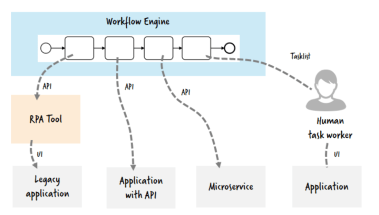RPA vs. APIs – which type of integration your business needs?
by Saurabh Sharma, on Nov 11, 2020 9:50:33 AM
RPA has gained mainstream adoption in enterprises as non-invasive integration for business users and even the way automation flows are developed on RPA platforms is similar to how you develop an integration flow on an integration PaaS (iPaaS) solution. Both type of software products use a “drag-and-drop” approach and pre-built components to achieve integration (or for simplicity, task automation in the case of RPA). No wonder there is still some confusion regarding when to use RPA or APIs for integration.
RPA is surface automation, faster and simpler for less-skilled users
RPA is well suited for integrating those applications that do not expose a web service or an API. In such cases, RPA enables surface automation at the user interface (UI) level. RPA provides quick wins and significant return on investment (RoI) in the short term and it is relatively easier to implement, with lower maintenance costs. In use case scenarios, where there is a large integration effort involved or IT budget constraint is an issue with an API-led approach to integration, RPA offers a quick-fix solution. RPA interacts with an application at the front end, whereas APIs interact with an application at the backend and enable deep integration.
APIs offer a simple yet flexible and scalable approach to enable enterprises to participate in and exploit the digital economy, and are no longer considered to be “humble” technical interfaces. APIs in their various guises facilitate the externalization of the enterprise, enabling the opening up of new revenue streams and simplifying the integration of digital sales, marketing, commerce, branding, and other channels into established business processes and models. With this background, it is quite clear that APIs are central to the integration infrastructure required to support digital business initiatives.
However, API integration is often messy and complex and beyond the core competencies of IT. In the case of small and mid-sized enterprises (SMEs), the proposition of maintaining dedicated and skilled resources to support integration requirements is not attractive, and is at times beyond their IT budgets. Along the same lines, the proposition of outsourcing integration work to system integrators (SIs) is not-so-attractive for SMEs. In such cases, RPA can deliver quick value without requiring a higher IT investment.
Both APIs and RPA are useful and complementary approaches to automation
Rather than debating RPA versus APIs, it is better for enterprises to use these complementary approaches for use cases better suited to each of them. For doing deep application integration where an API is available and the enterprise has required integration skills, Integration Platform as a Service (iPaaS) and other integration tools will be valuable. If it is about automating a series of mundane, repetitive tasks then RPA is a better option owing to faster implementation and lower cost of ownership.
There are a number of cases wherein RPA platform providers have partnered with iPaaS vendors to enable integration with a range of SaaS applications via connectors provided by iPaaS solutions. In large enterprises, where you have hundreds of applications (both on-premise and as SaaS), iPaaS can very well deliver the required application integration capabilities. Most of the iPaaS solutions provide pre-built connectors to a range of ERP, CRM, HCM, SCM, and office productivity applications, and using a drag-and-drop approach, it is easy to build integration flows for on-premise-to-SaaS and SaaS-to-SaaS integrations.
As RPA enters the mainstream and consumer-grade user experience (UX) with a graphical approach to the development of automation flows gains popularity, the barriers to adoption are significantly lowered, both in terms of skills required and the total cost of ownership of automation software. Then there are workflows where both RPA and APIs can be used for integration, RPA automates a series of tasks and APIs provide access to data from on-premise or SaaS applications to deliver a greater degree of automation.

Source: Bernd Ruecker, Medium
What wins finally, RPA or APIs?
RPA is a better option in cases wherein you can interact with an application only via the UI and API-led integration is not possible or ideal. Moreover, with changes in a process, it is relatively easier and less-expensive to do re-scripting for a bot rather than trying to change an integration flow developed using iPaaS or another integration tool. It is quite clear that both APIs and RPA have their pros and cons and with a systematic approach, both these two approaches can be used together to achieve integration and process automation in a complementary manner.

















